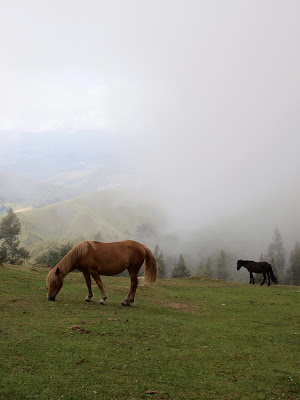We made it to Spain! The ocean! The beach! The air! This picture above is Pascal jumping off the sea wall in Biarritz, France actually. It's a tony town for sure, but a nice beach and real surf. For your ferrari driving caviar snacking surfer to be sure. The car garage was the best: we drove down, down, down in this cave-like garage to level -7. Opened the car doors, stretched our car-sitting tired legs, turned the corner and at the end of the exit tunnel is a perfectly framed view of the beach and ocean of Biarretz. Stunning! And so welcome after 6 hours in the car.

Above is our main beach in the town of Ribadisella, not far from our vacation house. We went here maybe 4 times. I rented a surf board and went surfing twice. The guys renting the surfboard were so apologetic about the waves that they let me surf for free the second time. The waves weren't actually that bad, also not that good, but it's summer afterall. I had a really fun time surfing, no crowds, pretty comfortable water temp in a 3/2mm wetsuit, and even some fun little waves (better than Pacifica, CA my old home break).
The air temperature was perfect, a modest 75 degrees maybe a little warmer in the full sun. The water temp was bracing at the beginning getting in, but actually you could swim in the ocean for a good 1/4 hour and feel comfortalbe without chilling down too far.


That's our house in the picture above. Look for the red roof in the right half of the picture just below the dark green and rocky hillside, and just above the light green hillside in the foreground.


The countryside in northern Spain is green, hilly and beautiful. Above are some of the views from our house. A huge mountain chain the Picos de Europe begins in this region, and right next to the coast. The air is fresh from the ocean, and when the beach is too hot, the mountains are only 10 minutes away. Our house was minutes up a one lane road snaking through pastures and little vegetable gardens. That's Sabine sitting on our patio overlooking a beautiful valley. In the mornings the mist would rise out of the valley to the clinking sounds of cow bells.

But Spain has tons of beaches right next to those mountains. Here's Pascal "not getting wet" this time. There are beaches, and beautiful ones all up and down the coast.
This is Carmalita the horse who spent the week in the field just at the beginning of the road to our vacation home. We pet her everyday on our way to and from the house. Several mornings, Anika and Tessa walked up the road from our house to feed Carmalita carrots.

Portrait of two clean, and ready for bed children.






























